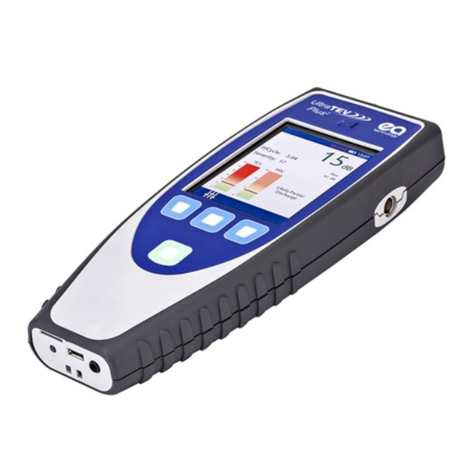EA Technology UltraTEV Plus2Operating Manual 2388L015
6.5 Using the virtual keyboard.............................................................................................. 39
6.6 Background Measurements............................................................................................. 40
6.7 Recording Data ................................................................................................................ 41
6.7.1 TEV recorded data................................................................................................ 41
6.7.2 Cable PD recorded data....................................................................................... 41
6.7.3 Ultrasonic recorded data ..................................................................................... 41
6.8 Viewing Survey Progress ................................................................................................. 42
6.9 Completing a Survey........................................................................................................ 42
7. Reviewing Results..................................................................................................................................................... 43
7.1 Wi-Fi & USB Connection ................................................................................................... 43
7.2 MicroSD Card & Data Zip Files ........................................................................................ 43
7.3 Data Analysis Screens...................................................................................................... 44
7.3.1 TEV & Cable PD Analysis Screen ......................................................................... 45
7.3.2 Ultrasonic Analysis............................................................................................... 46
8. Detecting Partial Discharge using the UltraTEV Plus² ........................................................................ 47
8.1 TEV Measurement ............................................................................................................ 47
8.1.1 Background Noise ................................................................................................ 47
8.1.2 Measuring TEV ..................................................................................................... 48
8.2 Cable PD Measurement ................................................................................................... 49
8.2.1 Practical RFCT Connection Requirements .......................................................... 49
8.2.2 Measuring PD in cables ....................................................................................... 49
8.3 Ultrasonic Measurement ................................................................................................. 50
8.3.1 Measuring Ultrasonic ........................................................................................... 50
8.3.2 Measuring Ultrasonic with the UltraDish Accessory.......................................... 50
8.3.3 Measuring Ultrasonic using the Flexi Probe sensor Accessory ........................ 52
8.3.4 Ultrasonic Measurement using the Contact Probe Accessory .......................... 53
8.3.5 Using the Ultrasonic Contact Probe.................................................................... 54
8.3.6 Detection, Measurement and Localisation of the Partial Discharge ................ 55
8.3.7 Mounting Practices .............................................................................................. 55
8.3.8 Sources of Noise and Phantom Signals .............................................................. 57
9. UltraTEV Plus² Specification ............................................................................................................................... 58
TEV Measurements .......................................................................................................... 58
Ultrasonic Measurements................................................................................................ 58
Cable PD Measurements.................................................................................................. 58
Hardware .......................................................................................................................... 59
Environmental .................................................................................................................. 59
Dimensions ...................................................................................................................... 59
Power Supplies ................................................................................................................. 59
Battery Charger ................................................................................................................ 60
10. Declaration of Conformity ................................................................................................................................... 61
11. Maintenance ................................................................................................................................................................. 62
12. Warranty Policy........................................................................................................................................................... 62
13. Calibration..................................................................................................................................................................... 63
14. Repair ............................................................................................................................................................................... 63
15. Waste Electrical and Electronic Equipment Directive (WEEE).......................................................... 63
16. Continuous Improvement .................................................................................................................................... 63
17. Contact Us ..................................................................................................................................................................... 64
18. Record of Changes ................................................................................................................................................... 65




























